Bar resonances
Velocity-space distribution of the solar neighborhood stars
The stars in the solar neighborhood exhibit a complex velocity-space distribution as shown in Fig. 1(a). This figure represents the radial velocity () versus azimuthal velocity () space distribution of stars located within 200 pc of the Sun, based on the Gaia DR3 catalog. Fig. 1(b) shows the same velocity-space distribution in a static axisymmetric disk model (Dehnen 1999’s distribution function) for comparison. While this model exhibits a smooth distribution, Fig. 1(a) reveals multiple overdensities, referred to as velocity-space substructures or moving groups. The significant number of stars in each substructure rules out Poisson noise as a plausible explanation, and these substructures likely originate from non-axisymmetric features such as the Galactic bar, spiral arms, or disrupted star clusters. The arrows in Fig. 1(a) indicate the names and locations of the major substructures. The most prominent one is the Hercules stream, located at . Originally identified as the Hercules (ζ Herculis) moving group by Eggen (1958), it was initially hypothesized to be a disrupted star cluster. Subsequent analysis using Hipparcos data (ESA 1997; Perryman et al. 1997) revealed that the moving group is part of a larger velocity-space substructure (Dehnen 1998). Fig. 1(c) shows the same velocity-space distribution as Fig. 1(a) but uses parallax, position, and proper motion data from the Hipparcos catalog. While the Hercules stream is clearly identifiable, its internal trimodal structure—visible in the Gaia data—is not resolved due to the limited number of stars and the lower astrometric accuracy of Hipparcos. The Hercules stream includes stars with a wide range of ages (Famaey et al. 2005). Therefore, non-axisymmetric dynamical structures, rather than a disrupted star cluster, provide a more reasonable explanation for its origin.
Resonances of the Galactic bar provide a plausible explanation for the formation mechanism of the Hercules stream. Dehnen (2000) demonstrated that the bar’s outer Lindblad resonance (OLR) forms the bimodality in the velocity-space distribution using a numerical simulation. Fig. 1(d) shows the velocity-space distribution generated with the galpy package following Dehnen (2000)‘s backward integration method. The distribution is segmented into the main mode at and the low- mode at , corresponding to the Hercules stream.
Regarding bar resonances, the most important parameter is the pattern speed. It determines the radius where a resonance occurs. If the Hercules stream originates from the OLR, its resonance radius is located inside the Sun’s radial coordinate ( kpc), and the corresponding pattern speed is (Dehnen 1999, 2000; Fux 2001; Minchev et al. 2007; Antoja et al. 2014).
However, recent direct and indirect measurements suggest a slower bar with (e.g., Portail et al. 2017; Bovy et al. 2019; Sanders et al. 2019; Binney 2020; Chiba et al. 2021; Kawata et al. 2021).
In the slow bar case, other resonances are located in the solar neighborhood. Scenarios explaining the origin of the Hercules stream via the corotation resonance have been proposed (e.g., Pérez-Villegas et al. 2017; Monari et al. 2019b; Binney 2020) as well as higher-order resonances, such as the 4:1 OLR (e.g., Monari et al. 2019a; Hunt & Bovy 2018).
Spiral arms and the combined effect of the bar and spiral arms have also been suggested to form a Hercules-like stream (Hattori et al. 2019; Barros et al. 2020).
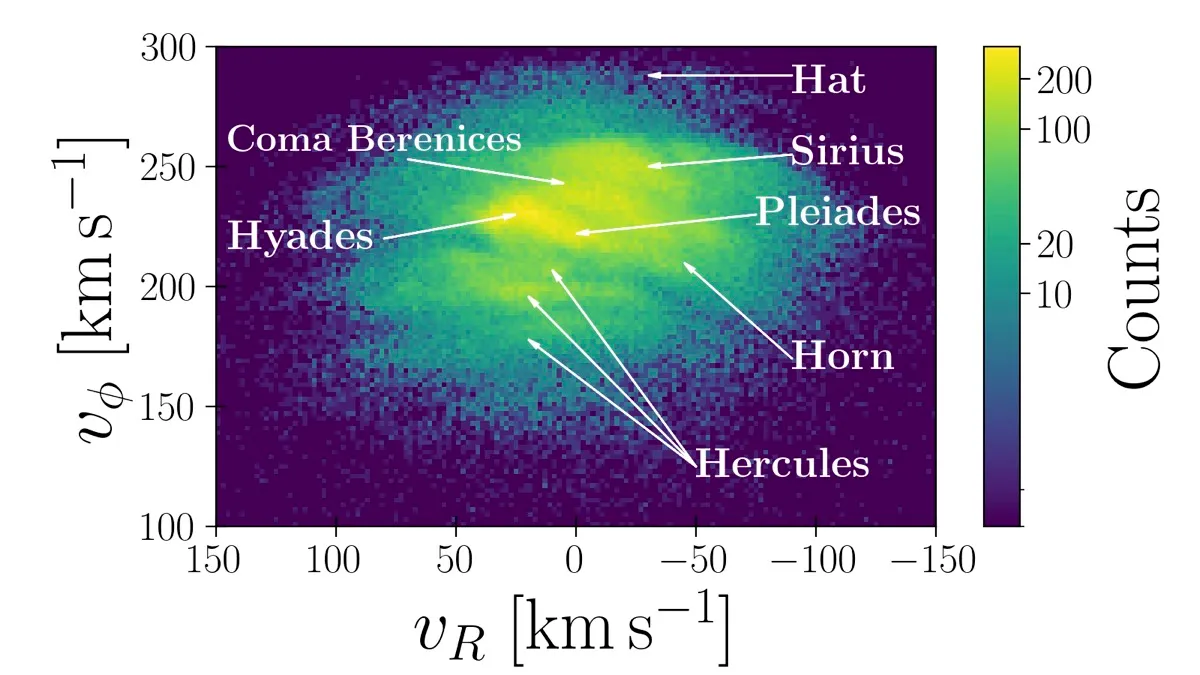
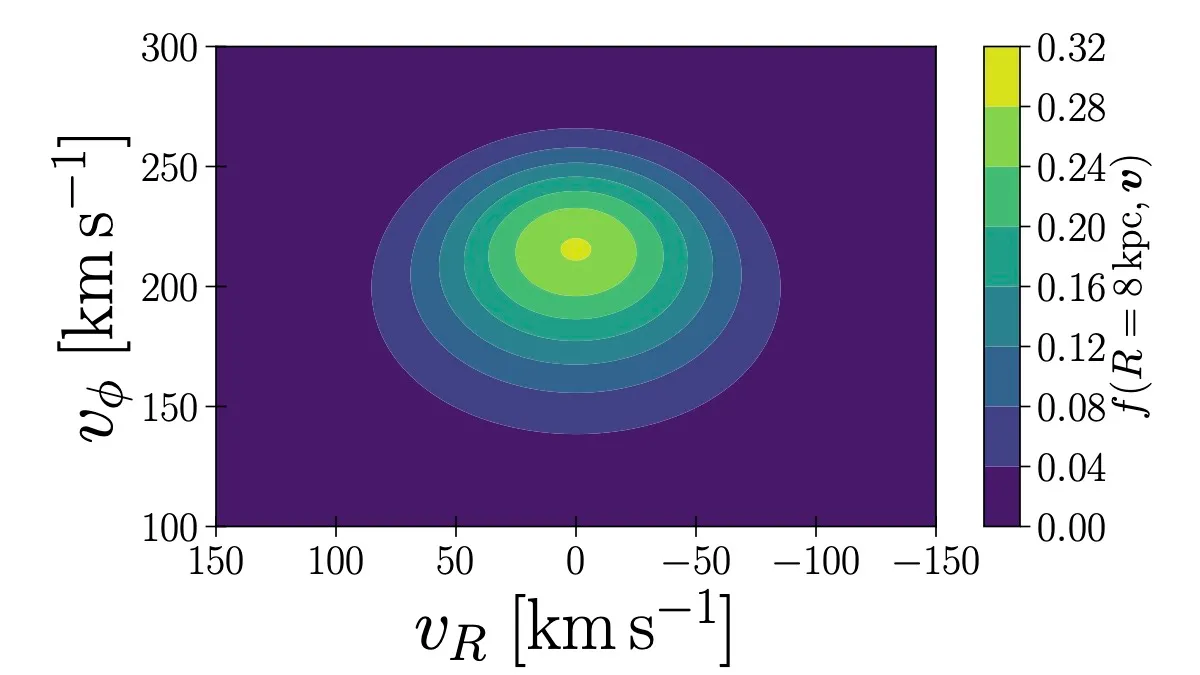
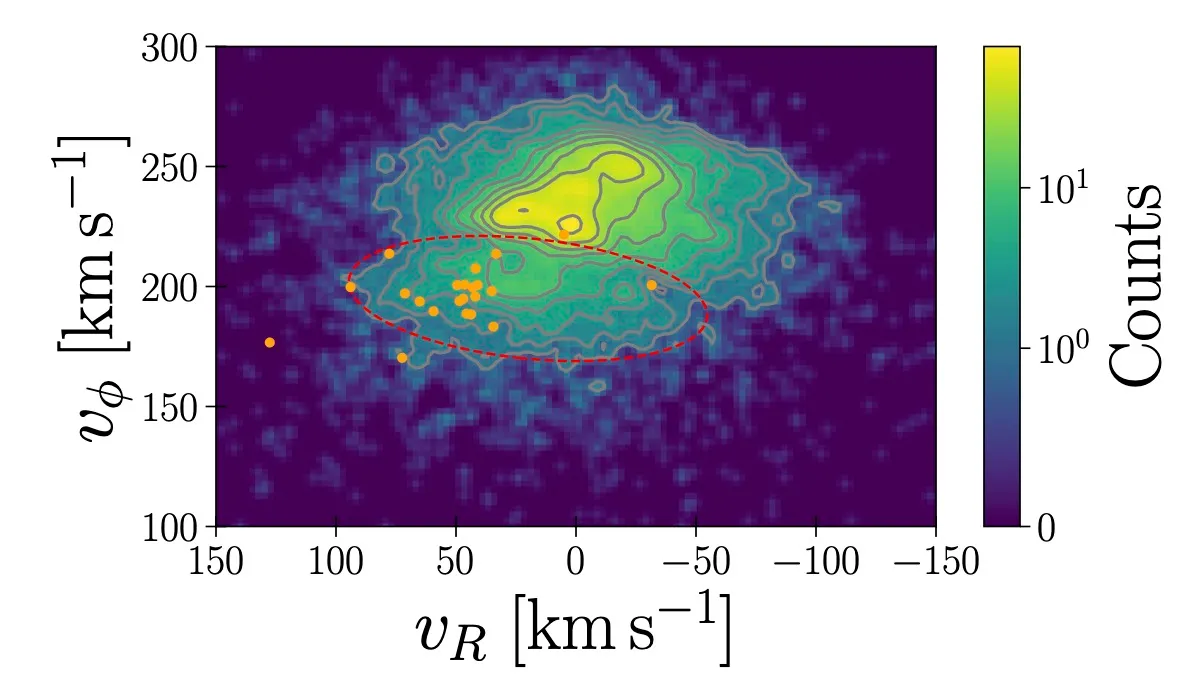
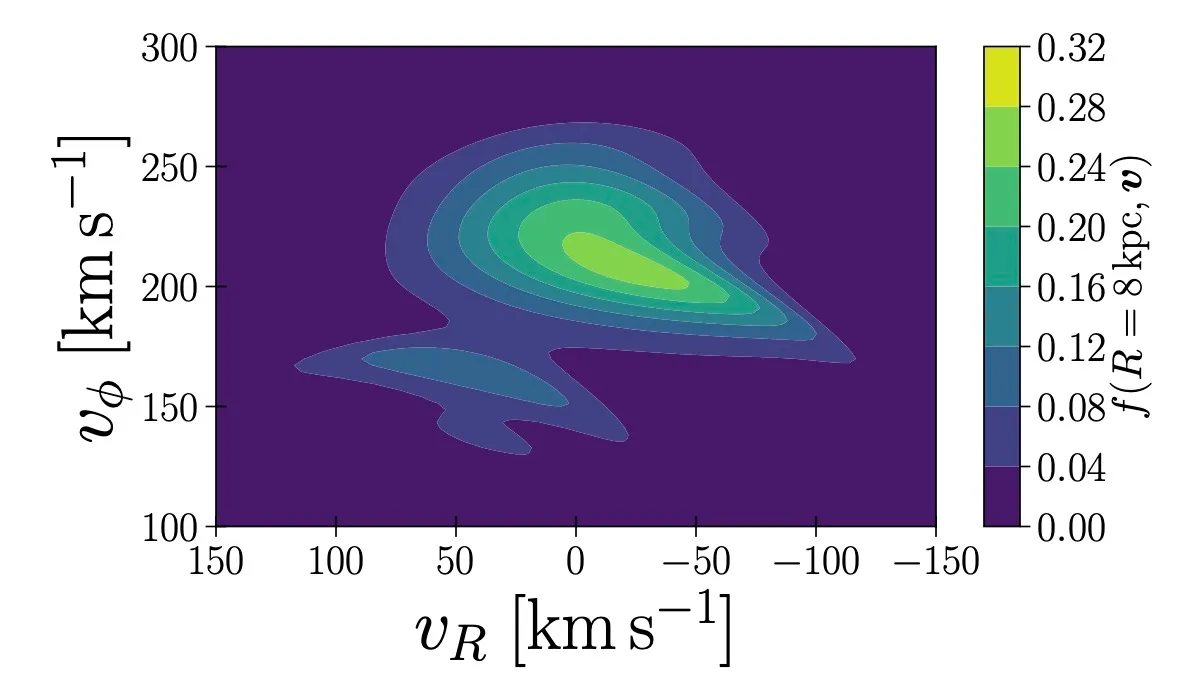
Figure 1. Velocity-space distribution of the solar neighborhood stars. (a) Gaia DR3 sample. (b) Axisymmetric disk model. (c) Hipparcos sample. Orange dots indicate the velocities of the 22 stars originally identified as the members of the Hercules moving group in Eggen (1958). Red ellipse indicates the location of the Hercules stream. (d) Dehnen (2000)‘s barred galaxy model.
Asano et al. (2020)
Asano et al. (2020) analyzed a high-resolution -body simulation of a Milky Way-like galaxy from Fujii et al. (2019) to investigate the origins of the velocity-space structures observed by Gaia. We identified a Hercules-like stream at in the model. It is close to the actual position of the Sun in the Milky Way. From a detailed orbital frequency analysis, we found multiple bar resonances in the “solar neighborhood” and their correspondence to velocity-space substructures. The Hercules-like stream is attributed to stars trapped in the 4:1 and 5:1 OLRs. The findings support the conclusion that the Hercules stream consists of stars trapped in multiple bar resonances, which also explains its trimodal structure as revealed by Gaia DR2. Furthermore, stars in the 2:1 and 3:1 OLRs correspond to the ‘hat’ and ‘horn’ structures, respectively.
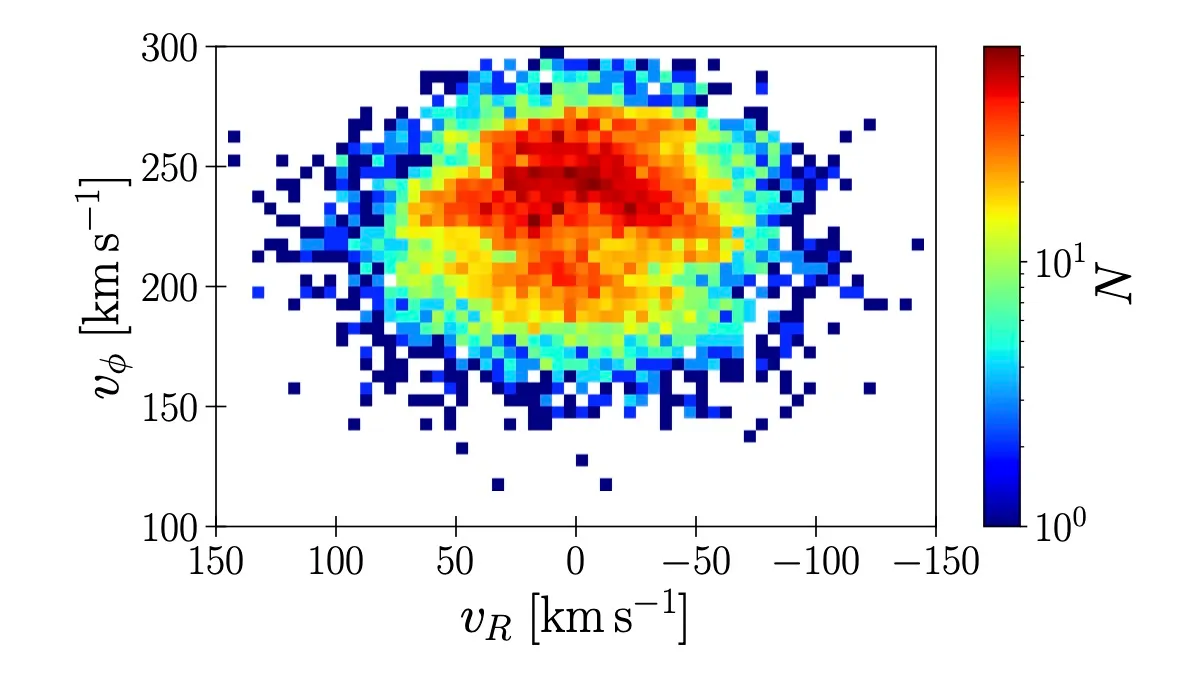
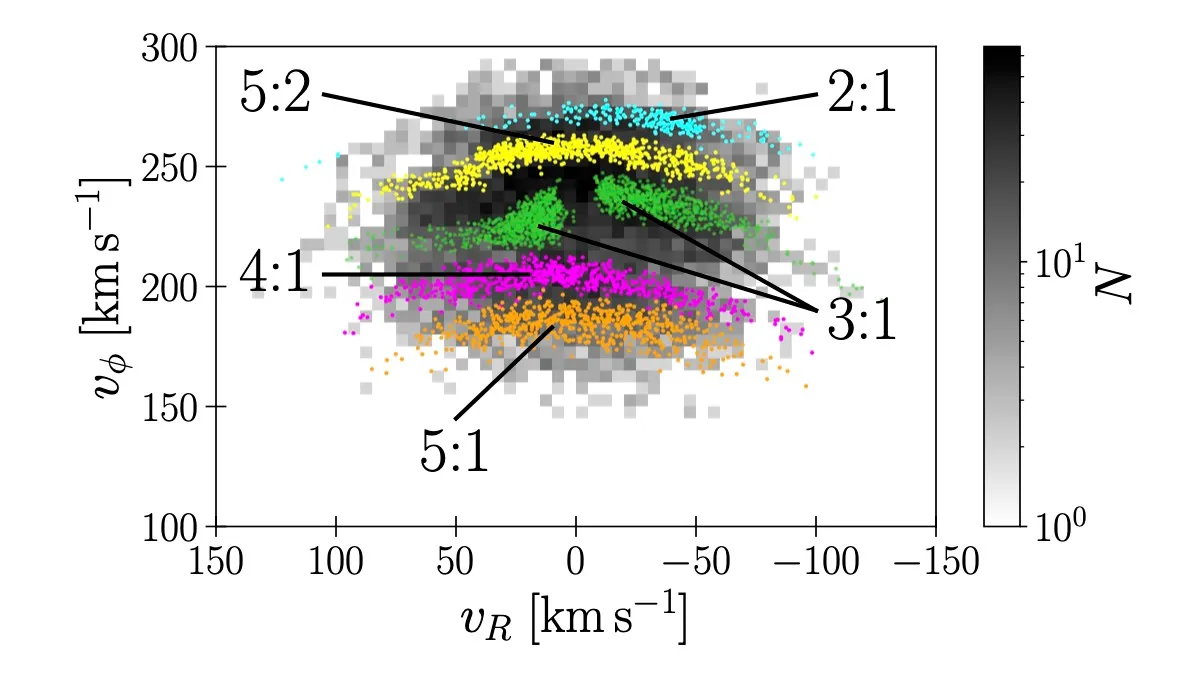
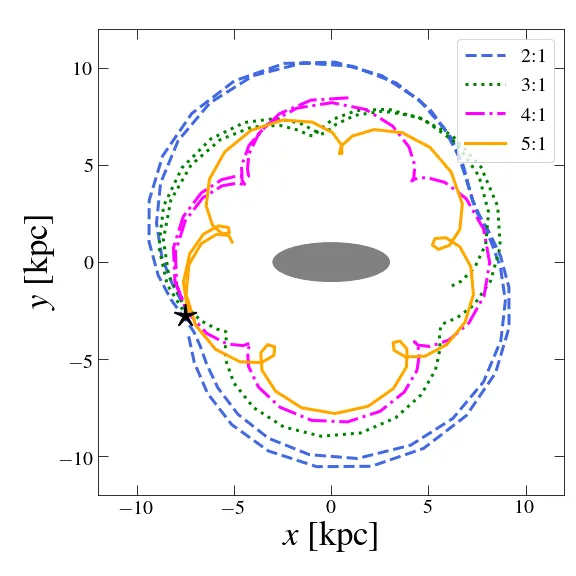
Figure 2. (a) - space distribution of the -body particles. (b) Distribution of resonantly trapped particles in the - space. The background map is the same as in the panel (a). (c) Shapes of the resonant orbits in the bar’s rotating frame.
We also compared the distribution of stars in the - plane in the simulation with that obtained from the Gaia data. Resonantly trapped particles in the simulation follow ridges in the - plane. Similar ridges have also been identified in the Gaia data. By matching the observed ridges with theoretically expected ridge patterns, we demonstrated that resonances caused by a relatively slow bar (—) can explain the observed ridges.
Asano et al. (2022)
Asano et al. (2022) used Kullback-Leibler divergence (KLD) to quantitatively evaluate the similarities of the velocity-space distributions in the -body model and those of stars within 200 pc of the Sun, as observed by Gaia.
The results showed that:
- The KLD fluctuates with time, which indicates that the velocity-space distribution at a fixed position, for instance , is not always similar to that of the solar neighborhood. This reflects the non-static dynamic nature of the galactic potential in the -body simulation.
- Some positions in the simulated disk show velocity-space distributions with small KLDs (high similarities) more frequently than others. One such position is . This is consistent with the observationally suggested solar position in the Milky Way.
- The detection frequency of small-KLD velocity distributions is higher in the inter-arm regions than in the arm regions. This suggests that spiral arms may disrupt the velocity-space substructure formed by bar resonances.
- Small-KLD velocity distributions are made up of particles trapped in bar resonances. In particular, Hercules-like streams consist of the 4:1 and 5:1 OLRs. Bar resonances have a significant impact on the stellar velocity-space distribution, even though the Galactic potential is not static.
We concluded that this study provided further evidence that the Hercules stream is formed by bar resonances and that higher-order bar resonances (like the 4:1 and 5:1 OLRs) are important for shaping the velocity-space distribution of stars in the solar neighborhood.
